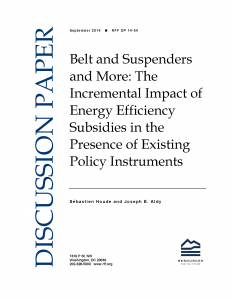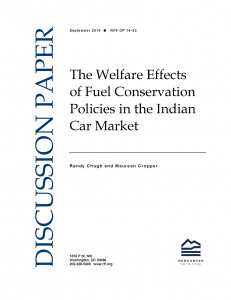Belt and Suspenders and More: A Look at the Incremental Impact of Energy Efficiency Subsidies
 Lawmakers employ a number of policy instruments to promote energy efficiency, including regulatory mandates, information campaigns, and technology subsidies. For energy-consuming durable goods, consumers often purchase products ultimately eligible for a subsidy because of their design under an energy efficiency standard and marketing subject to government-required information disclosure policies. Appliances such as refrigerators, dishwashers, and clothes washers, for example, fall into this category—they are subject to minimum energy efficiency standards set at the federal level and eligible for various rebates and tax credits, and manufacturers are required to disclose typical annual energy usage. Against the reality of limited resources and in a complicated landscape of overlapping, often redundant policy tools in play, what is the incremental impact of energy efficiency subsidies on energy outcomes, and why is it important?
Lawmakers employ a number of policy instruments to promote energy efficiency, including regulatory mandates, information campaigns, and technology subsidies. For energy-consuming durable goods, consumers often purchase products ultimately eligible for a subsidy because of their design under an energy efficiency standard and marketing subject to government-required information disclosure policies. Appliances such as refrigerators, dishwashers, and clothes washers, for example, fall into this category—they are subject to minimum energy efficiency standards set at the federal level and eligible for various rebates and tax credits, and manufacturers are required to disclose typical annual energy usage. Against the reality of limited resources and in a complicated landscape of overlapping, often redundant policy tools in play, what is the incremental impact of energy efficiency subsidies on energy outcomes, and why is it important?
In a new RFF discussion paper, we investigate the impact of the largest subsidy program for energy efficient appliances implemented in the United States. Determining the incremental impact of subsidies in this context is important for three reasons. First, subsidy instruments, such as tax credits and rebates, have frequently been “turned on” for short periods of time and then “turned off” (for example, through the one-time 2009 economic stimulus bill, occasional tax extender bills, and occasional utility rebate programs). For this reason, subsidies, in practice, appear to be a marginal policy measure where energy efficiency is concerned. Second, subsidies are the marginal policy lever on the extensive margin, which facilitates our analysis since we clearly observe when the programs turn on and off, in contrast to the gradual changes in the revision of minimum efficiency standards and mandatory information disclosure. Third, such subsidies may be employed to an even greater extent in the future, making current analysis important for future decisionmaking. Read More
The Role of Energy Efficiency in EPA’S Clean Power Plan
This is the fourth in a series of questions that highlights RFF’s Expert Forum on EPA’s Clean Power Plan. Readers are invited to submit their own comments to the questions and/or the responses using the “Leave a Comment” box below. See all of the questions to date here.
RFF asks the experts: Did EPA appropriately construct building block 4?
Expanding utility and state efforts to promote greater efficiency in electricity use (the fourth building block in EPA’s proposed Clean Power Plan) will reduce demand on power plants, thereby reducing emissions and saving money for electricity consumers. To set the state-specific emissions rate reduction goals laid out in EPA’s proposal, the agency determined that each state can eventually achieve a 1.5 percent savings in energy consumption per year based on energy efficiency resource standard goals that have been adopted or recently achieved in selected states. Did EPA appropriately construct building block #4?
 “Building block [#4] was constructed in a reasonable way, although [ACEEE] will be suggesting some refinements and improvements in our formal comments to EPA. . . . With these refinements, [we estimate] that the energy efficiency savings and emissions reductions could more than double.”
“Building block [#4] was constructed in a reasonable way, although [ACEEE] will be suggesting some refinements and improvements in our formal comments to EPA. . . . With these refinements, [we estimate] that the energy efficiency savings and emissions reductions could more than double.”
—Steven Nadel, Executive Director, American Council for an Energy-Efficient Economy (ACEE) (See full response.)
 “EPA has not appropriately constructed building block #4 and has substantially overstated the amount of [energy efficiency] that could be achieved by states in the future in setting the 111(d) CO2 standards.”
“EPA has not appropriately constructed building block #4 and has substantially overstated the amount of [energy efficiency] that could be achieved by states in the future in setting the 111(d) CO2 standards.”
—Bruce Braine, Vice President, American Electric Power (See full response.)
 “The approach that EPA takes raises a couple of questions about the cost-effectiveness of this particular building block. . . . First, states with ambitious existing energy efficiency programs tend to have a larger obligation. . . . Second, state targets under building block #4 are not differentiated based on the potential for associated carbon reductions.”
“The approach that EPA takes raises a couple of questions about the cost-effectiveness of this particular building block. . . . First, states with ambitious existing energy efficiency programs tend to have a larger obligation. . . . Second, state targets under building block #4 are not differentiated based on the potential for associated carbon reductions.”
—Karen Palmer, Research Director and Senior Fellow, Resources for the Future (See full response.)
RFF on the Issues: Economics and the environment; EPA Clean Power Plan comment period extended
Economics and the Environment
Today marks the beginning of Climate Week NYC 2014, which will feature more than 100 events around New York City in support of the UN Climate Summit. Summit representatives are expected to discuss the economic benefits of carbon pricing and national climate commitments, as well as the ability of cities to offer policymakers “some of the lowest-hanging fruit” for preventing damages from climate change.
During Climate Week, join RFF for an RFF Policy Leadership Forum on Economics and the Environment, with EPA Administrator Gina McCarthy. Tune in on September 25 to view the live webcast at www.rff.org/live. Questions can be submitted via Twitter using #AskRFF and will be answered as time permits.
EPA Clean Power Plan Comment Period Extended
The deadline to submit comments on the EPA’s Clean Power Plan has been extended to December 1, though the agency is “still working towards a June deadline” for its finalized regulation. The 45-day extension was granted by the Obama administration to give the public a greater opportunity to offer additional input that will ultimately result in a “practical, flexible, and achievable” plan.
In a new installment of RFF’s Expert Forum on the Clean Power Plan, experts from RFF, Alstom Power, and NRG Energy comment on the practicality of the plan’s assumption that existing natural gas power plants can meet an average utilization of 70 percent. Readers are encouraged to share their thoughts on this question and more by commenting on Common Resources.
This Week in the RFF Library Blog
Each week, we review the papers, studies, reports, and briefings posted at the “indispensable” RFF Library Blog, curated by RFF Librarian Chris Clotworthy.
A Global High Shift Scenario: Impacts And Potential For More Public Transport, Walking, And Cycling With Lower Car Use
[Yale Environment 360] Expanding public transportation and infrastructure that promotes walking and biking throughout the world’s cities could save $100 trillion and cut transportation-related carbon emissions by 40 percent by 2050, according to an analysis by researchers at the University of California, Davis, and the Institute for Transportation and Development Policy. Urban transportation accounted for roughly one-quarter of all transportation-related emissions in 2010, the report said, and these emissions could double by 2050 as growth continues in major cities in China, India, and other developing countries. – via Univ. of California Davis | Institute for Transportation and Development Policy
Household Electricity Expenditures as a Percentage of Income 2008-2012
[WFPL] A new data mapping project from the Kentucky Energy and Environment Cabinet highlights the disparities in income and electricity prices both around the country and in the commonwealth. The Kentucky Department of Energy Development and Independence took median household income data from the American Community Survey, and combined that with federal Energy Information Administration data on electricity prices. The result is a national heat map that shows the areas where residents devote more of their household income to paying their electric bills. – via Kentucky Energy and Environment Cabinet, Department for Energy Development and Independence
Fuel Conservation Policies in the Indian Car Market: Examining the Welfare Effects
 India’s car market has expanded rapidly since the country’s economic reforms in the early 1990s, a trend that is expected to continue well into the future; its passenger fleet alone is projected to swell from 22 million to 112 million vehicles between 2010 and 2030. In the wake of this growth, India is considering the adoption of fuel economy standards in its quest to curb fuel usage and foreign oil dependence. At the same time, India’s lenient taxation of diesel fuel (selling 30 to 50 percent below petrol) has worked against it by encouraging market “dieselization” and overall diesel consumption by new car owners.
India’s car market has expanded rapidly since the country’s economic reforms in the early 1990s, a trend that is expected to continue well into the future; its passenger fleet alone is projected to swell from 22 million to 112 million vehicles between 2010 and 2030. In the wake of this growth, India is considering the adoption of fuel economy standards in its quest to curb fuel usage and foreign oil dependence. At the same time, India’s lenient taxation of diesel fuel (selling 30 to 50 percent below petrol) has worked against it by encouraging market “dieselization” and overall diesel consumption by new car owners.
India has significant potential to meet its goals through a tax on diesel fuel that could correct some of the imbalances created by its current policy, though a tax on diesel vehicles themselves would be a more politically feasible option. In our new RFF discussion paper, we consider the welfare implications of a price-equalizing diesel fuel tax, a diesel car tax that would prompt a similar market share reduction in diesel cars, and a smaller diesel fuel tax that would result in the same fuel savings as a car tax. To quantify the efficiency of a fuel tax relative to a car tax, we use a JD Power APEAL survey to model joint consumer decisions about which car to buy and how much to drive it based on the strategy in place. Read More
How US Gridlock May Handicap Climate Leadership
Next week, world leaders will meet at the United Nations in New York City at the invitation of UN Secretary-General Ban Ki-moon. The purpose of the meeting is to discuss actions the leaders will take to limit their country’s emissions of greenhouse gases in an effort to forestall global climate change. For many, success of the meeting will be measured by the ambition of the stated actions—that is, how aggressive will the emissions reductions offered by each country be?
Although ambition may be a good measure of success, climate policy watchers will be just as interested in the specific actions that give rise to the stated emissions reductions. It is the efficacy of the action that makes stated ambition credible but, unfortunately, there are many ineffective actions that can be taken.
One heavy-hitting climate policy watcher is World Bank Special Envoy for Climate Change Rachel Kyte. Earlier this year, Kyte reiterated her support for climate policy actions that take the form of prices on emissions of carbon dioxide (often termed “carbon pricing”). She encouraged “countries, sub-national jurisdictions, and companies to join a growing coalition of first movers to support putting a price on carbon.” The governments and organizations comprising this coalition are not supporting a specific level of ambition in terms of emissions reductions; rather, they are supporting a specific effective action—carbon pricing. Read More
The Role of Existing Natural Gas in EPA’s Clean Power Plan
This is the third in a series of questions that highlights RFF’s Expert Forum on EPA’s Clean Power Plan. Readers are invited to submit their own comments to the questions and/or the responses using the “Leave a Comment” box below. See all of the questions to date here.
RFF asks the experts: Is it possible for existing natural gas power plants to increase average utilization by 70 percent (building block #2) and, if so, at what cost?
With a boom in natural gas production in the United States, many view this fuel source as a possible “bridge” to a low-carbon future. In fact, building block #2 of EPA’s Clean Power Plan assumes that states can increase the average utilization of existing natural gas power plants to 70 percent, substantially higher than current rates. RFF asked the experts about the practicality and cost-effectiveness of this building block. Do such opportunities exist, and at what cost? Would an increase in the utilization of existing gas facilities render them unavailable to balance the intermittent supply from renewable energy generation?
Is it possible for existing natural gas power plants to increase average utilization by 70 percent (building block #2) and, if so, at what cost?
 “Recent history suggests a dramatic change in capacity factor is very possible, but prior experience does not provide evidence that it would be sufficient to achieve the building block target of 70 percent on average for all gas plants.”
“Recent history suggests a dramatic change in capacity factor is very possible, but prior experience does not provide evidence that it would be sufficient to achieve the building block target of 70 percent on average for all gas plants.”
—Dallas Burtraw, Darius Gaskins Senior Fellow, Resources for the Future (See full response.)
 “If you address this from the technical perspective, there is no question that the natural gas combined cycles that EPA focuses on are fully capable achieving and maintaining a 70 percent capacity factor. To achieve this, however, four issues will need to be addressed with careful modeling and planning.”
“If you address this from the technical perspective, there is no question that the natural gas combined cycles that EPA focuses on are fully capable achieving and maintaining a 70 percent capacity factor. To achieve this, however, four issues will need to be addressed with careful modeling and planning.”
—Robert Hilton, Vice President, Power Technologies for Government Affairs, Alstom Power Inc. (See full response.)
 “A more gradual phase-in of building block #2 over time would avoid this reliability-driven rush to new gas-fired generation, . . . allow a more thoughtful transition to increasingly competitive renewables and other clean energy resources, . . . and lower CO2 emissions from the power sector as a whole at a lower cost.”
“A more gradual phase-in of building block #2 over time would avoid this reliability-driven rush to new gas-fired generation, . . . allow a more thoughtful transition to increasingly competitive renewables and other clean energy resources, . . . and lower CO2 emissions from the power sector as a whole at a lower cost.”
—Steve Corneli, Senior Vice President, Policy and Strategy, NRG Energy (See full response.)
Examining the Market Structure of Shale Gas Drilling in the United States
 Over the last decade, the shale gas boom has emerged as the biggest story in US energy. Gas extracted from shale formations accounted for only 1.6 percent of total US natural gas production in 2000, a share that ballooned to more than 40 percent by 2013. Its transformative influence on the American energy industry has led many scholars and policymakers to explore what factors were at work in shale’s initial development and explosive growth. The market structure behind the shale expansion is commonly cited, and is of particular interest to countries currently attempting to develop their own shale gas resources.
Over the last decade, the shale gas boom has emerged as the biggest story in US energy. Gas extracted from shale formations accounted for only 1.6 percent of total US natural gas production in 2000, a share that ballooned to more than 40 percent by 2013. Its transformative influence on the American energy industry has led many scholars and policymakers to explore what factors were at work in shale’s initial development and explosive growth. The market structure behind the shale expansion is commonly cited, and is of particular interest to countries currently attempting to develop their own shale gas resources.
An often-repeated but unsubstantiated market claim by industry and media observers is that the US shale industry was created by thousands of small- and medium-sized firms, with drilling dominated by mom-and-pop companies. This view has already influenced policymaking in countries such as China, where shale development has been opened to newly established small firms with little or no prior drilling experience. In a new RFF discussion paper, we conduct the first empirical study of the structure of the US shale gas drilling market and prove that these common views of the industry are both inaccurate and misleading. Read More
RFF on the Issues: UN climate summit; Clean Power Plan extension
UN Climate Summit
“Catalyzing Action” is the theme for the 2014 UN Climate Summit on September 23. Leaders and policymakers attending the event are expected to discuss how taking action to prevent climate change “can advance the direct interests of nations, businesses and communities,” ideally motivating countries to make long-term commitments to economic sustainability.
In a new blog post, RFF’s Ray Kopp highlights the importance of accounting for participant interests when designing international climate agreements. He writes: “No matter how the legality of country commitments under the new agreement is treated—under international or domestic law—continued compliance with commitments and a willingness to increase the commitments over time will depend on each country’s internal assessment of the benefits it receives from remaining a party to the agreement.”
Clean Power Plan Extension
Fifty-three senators have expressed support for lengthening EPA’s Clean Power Plan’s open comment period—which currently ends October 16th—by an additional 60 days. The group has advised that “in light of the complexity and scope of the regulation,” EPA should consider extending its collection of public input on the plan’s state targets and the building blocks of its proposed best system of emissions reduction.
In a new question series, RFF asked experts from around the country to weigh in on a number of issues related to the implementation of the Clean Power Plan, including the definition of the “best system of emission reduction” and the translation of states’ rate-based goals into mass-based goals. More questions will be posted in the coming weeks. Readers are also encouraged to share their thoughts on these questions and responses by commenting through RFF’s blog, Common Resources.
Managing Invasive Species: Examining Individual and Cooperative Approaches
Invasive species impose severe ecological and economic changes on their new ecosystems—the United States alone suffers billions of dollars’ worth of damage every year due to the introduction and proliferation of non-native species. Bioinvasions often are viewed as a problem to be tackled by a top-down central decisionmaker seeking to control invaders across large swaths of public land. In many regions around the world, however, bioinvaders spread, without regard to jurisdictional boundaries, over large landscapes that contain numerous, independently owned parcels of land, complicating control efforts.
In a new article in the American Journal of Agricultural Economics, “Individual and Cooperative Management of Invasive Species in Human-Mediated Landscapes,” my colleague James Wilen and I model the spread of invasive species and their spatial-dynamic externalities to explore how and when bottom-up coordinated control among independent landowners might achieve socially desirable levels of invasion control. How expansive would such cooperative management agreements need to be, and under what economic and invasion conditions are they likely to be most effective? Read More

 Subscribe; to our RSS Feed
Subscribe; to our RSS Feed Tweets by @RFF_org
Tweets by @RFF_org 
Recent Comments